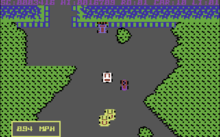Bump 'n' Jump
| Bump 'n' Jump | |
|---|---|
| Arcade flyer of Bump 'n' Jump (1982). | |
| Developer(s) | Data East |
| Publisher(s) | Data East, Bally Midway, Vic Tokai (NES) |
| Platform(s) | Arcade |
| Release date(s) | 1982 |
| Genre(s) | Driving game |
| Mode(s) | 1P, 2P (alternating) |
| Cabinet | Upright, cocktail |
| CPU | 1x 6502 @ 750 kHz |
| Sound | 2x AY-3-8910 Namco WSG @ 1.5 MHz MHz |
| Display | Raster, 240 x 256 pixels (Vertical), 16 colors |
Bump 'n' Jump, known in Japan as Burnin' Rubber (バーニンラバー Bānin Rabā), is a 1982 Japanese arcade game created by Data East Corporation, released as both a dedicated board and as part of their DECO Cassette System. The game was published in certain regions by Bally Midway.
In Bump 'n' Jump the goal is to drive from the beginning of a level to the end while bumping enemy vehicles into obstacles and jumping over various large obstacles such as bodies of water.

Gameplay
Due to the bird's eye view, players cannot see the large obstacles until it is too late to jump, so the game displays a flashing exclamation point when the large obstacles are about to appear.
The enemy vehicles are separated into cars and trucks. Cars can be bumped into obstacles or jumped upon and destroyed, while trucks cannot be bumped; they can only be jumped upon to destroy them, and will sometimes drop obstacles that will destroy the player or one extra life. At the end of each level players receive bonus points for the number of enemy vehicles crashed. Going from one level to another is characterised by a change of seasons. Apart from the change of scenery, the winter scenario also features the additional challenge of slippery roads. Players get points for bumping other cars and causing the other cars to crash, but one bonus isn't apparent: If the player completes a level without bumping another car, the player receives a huge point bonus.
Ports
Ports of the game have also been released on Atari 2600 and Intellivision in 1983, the ColecoVision and Commodore 64 in 1984, and the for the Nintendo Entertainment System (published by Vic Tokai) in 1988. The NES version was also released in Japan as Buggy Popper (バギー・ポッパー).
Adding a level of complexity, the NES version of the game also requires that players pick up cans of gasoline that are interspersed throughout each course, as their car uses up fuel steadily throughout the game if the car goes too fast.
The C64 version uses the chorale parts of Johann Sebastian Bach's Herz und Mund und Tat und Leben cantata for the soundtrack.
Highest score
On 25 December 2011, Charlie Wehner of Missouri beat the Bump 'n' Jump world record with a score of 3,175,880.[1]
The world record using MAME was achieved by John McNeill of Brisbane, Australia on 2 March 2012 with a score of 2,531,168.[2]
See also
- Spy Hunter, another game where you can bump vehicles off the road
External links
- Bump 'n' Jump at the Killer List of Videogames
- Bump 'n' Jump guide at StrategyWiki
- Bump 'n' Jump at MobyGames
- Twin Galaxies High Score Rankings on Bump 'n Jump
- The ColecoVision prototype version of Bump 'n' Jump can be played for free in the browser at the Internet Archive
Notes
- ↑ "Twin Galaxies' Bump 'n' Jump High Score Rankings". Retrieved 7 September 2012.
- ↑ "Twin Galaxies' Bump 'n' Jump High Score Rankings". Retrieved 8 June 2013.